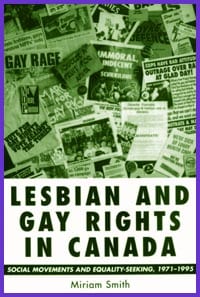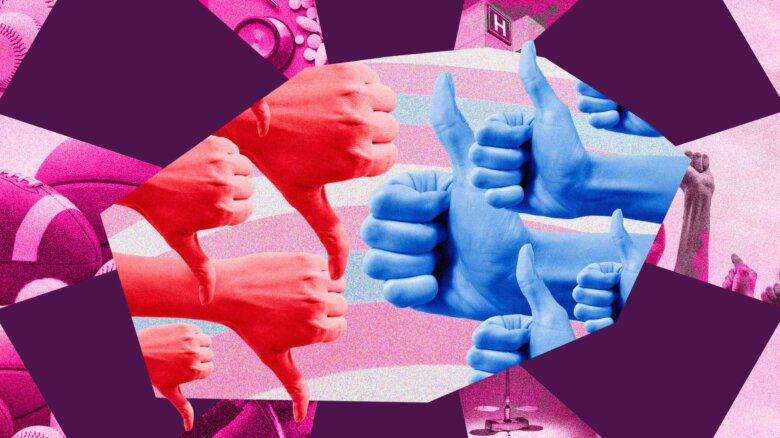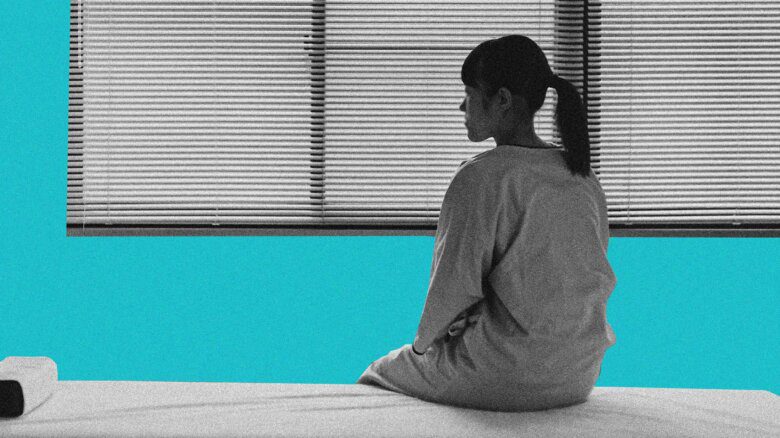The strategy for winning gay and lesbian rights in Canada has changed dramatically since activists formally began their work in the early 1970s.
What started out as a larger vision that would change the way all people, hetero and homo, thought of sexuality, has become more narrow. Since the adoption of the Canadian Charter Of Rights And Freedoms in 1982, there has been a swing of resources away from gay liberation and toward legal battles for civil rights.
In this excerpt from her book Lesbian And Gay Rights In Canada: Social Movements And Equality-Seeking, 1971-1995, author Miriam Smith looks at the early movement in Canada, and how it was already dealing with the issue. The book is published by University Of Toronto Press book and costs $17.95 in paperback.
***
The demand for civil rights was central to gay liberation during the seventies, based on the strategic and ideological frame provided by the US civil rights movement, the women’s movement and the institutional opening provided by human rights commissions.
The struggle for lesbian and gay civil rights was seen in the mainly male gay liberation movement, in the mainstream gay media, and in gay liberation political organizations of the seventies, as inextricably linked to the goal of liberation. While the achievement of rights was significant in itself, it was also a strategy for building a social movement, for creating gay community, for raising gay consciousness, and for bringing gays out of the closet, in short, for the creation of political identity.
Tactically, rights claims were not confined to litigation and courts, but were the organizing frame used by gay liberation groups across a range of strategies and tactics, including lobbying government, electoralism, picketing and demonstrations.
For example, the first systematic discussion of the ideology of gay liberation, which appeared in the third issue of The Body Politic [the defunct magazine published by Pink Triangle Press, which now publishes Xtra] in March 1972, argued that civil rights was the key issue that could unite all gays and would thus serve as a rallying cry and point of unity for the community.
Brian Waite, the author of the article, argued that “Winning this demand, in itself, will not end our oppression, but in the process of fighting for it many gay men and women will develop a higher level of pride and consciousness.” In addition, the substantive achievement of formal equality rights would help build the gay and lesbian movement because, “With a victory, thousands more will find it easier to come out… without fear of losing a job or apartment, being harassed at school, or facing discrimination in innumerable, other ways because we have no rights guaranteed by law.”
Similarly, The Body Politic collective argued in the spring of 1973 that “there is no contradiction between the present focus of the struggle, civil rights and the final object, the full liberation of the human personality, straight and gay alike. Gays are coming to comprehend that the two are intimately interconnected. The present civil rights fight, which is in fact only just beginning, will facilitate the creation and development of a gay liberation consciousness.”
As Chris Bearchell recalled, “how we saw the gay rights strategy was [as] something that would radicalize… politicize, and mobilize people… The process of being radicalized and politicized and mobilized would mean that the people who were drawn into the process would realize that rights in and of themselves were insufficient… And I think the hope would be that, in making that realization, that they would… understand the shortcomings of the way the world was organized.”
In The Body Politic in 1975, Ken Popert pointed out that the goal of the civil rights strategy was not to change the law but to raise awareness, especially outside the lesbian and gay communities:
“But why should that struggle be one for ‘civil rights’? The history of minority rights reveals that civil rights accomplish little without a corresponding change in public opinion. But the effectiveness of civil rights is much less important than the effectiveness of the public campaign which demands those rights. Of all the questions raised by gay liberation, the issue of civil rights is the one which attracts the greatest support, from gays and straights alike. By a campaign for civil rights, we can penetrate the media and advance the re-education of the public on the subject of homosexuality…. It cannnot be emphasized too strongly that the campaign for civil rights is a means and not an end.”
And, at the Second Annual Gay Rights Conference in 1974, the adoption of a civil rights platform was seen by delegates as “an important step towards an outward oriented, militant movement.”
Like the US civil rights movement of the fifties and sixties, the rights frame of the main political organization of gay liberation emphasized formal equality, particularly in the areas of employment and housing. Yet the full implications of equality, including relationship recognition, were demanded from the beginning. For example, the brief presented to the federal Parliament in 1971 demanded equal rights in employment, but also “legal rights for homosexuals which currently exist for heterosexuals including an end to discrimination in adoption, public housing, taxes and pension benefits.”
GATE [Gay Alliance Toward Equality] Vancouver’s 1971 statement of principles listed its goals as “full equality for gay people in every area of life and endeavor,” protection from discrimination in housing and employment, and “the right to homosexual marriage and divorce, recognized by law as the union of two equal partners.”
If the goal of gay liberation was societal transformation and if building a lesbian and gay community was key to this goal, then the first step in the process of building a social movement was for people to come out. People would be more likely to do that if they had a meaning frame available that said “gay is good,” a major slogan of gay liberation in the ’70s, and when they no longer feared employment and housing discrimination as a direct consequence of being out.
In the context of the gay liberation movement then, the formal equality of civil rights frame was a classic statement of the personal as political.

 Why you can trust Xtra
Why you can trust Xtra


